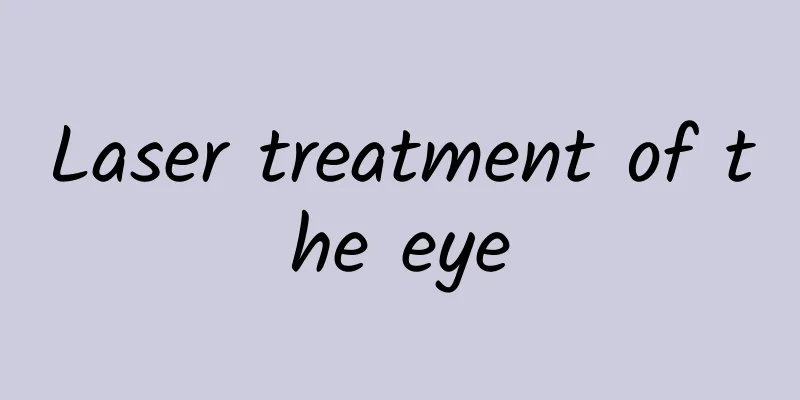Laser treatment of the eye

|
"Computers store thousands of books, and lasers can penetrate thousands of layers of nails." This is a line from a poem by contemporary poet Tian Ao. Everyone is familiar with computers, but are you familiar with lasers? When we go to the ophthalmology department for treatment, we often hear that we need to use lasers on our eyes. What eye diseases can lasers treat? In fact, many eye diseases can be treated with lasers. Lasers can be used to treat fundus diseases, glaucoma, corneal diseases, cataracts, and corneal refractive surgery. Laser is different from ordinary light, and its energy is very high. However, there are two forms of laser energy release, one is continuous laser and the other is pulsed laser. Continuous laser is laser irradiation without interruption, expressed in power, the unit is watt, argon laser and krypton laser are continuous lasers; pulsed laser is laser irradiation without interruption, that is, the laser is constantly "on and off", expressed in unit pulse energy, the unit is joule, femtosecond laser is pulsed laser, and each time it is on, it is very short, only a few hundred femtoseconds. The effect of laser treatment, in addition to being related to power and energy, is also related to irradiation time and spot size. Lasers, like ordinary light, are colored, and the color is related to the wavelength of the laser. Commonly used lasers in ophthalmology include: argon lasers have 488 nanometers of blue light and 514.5 nanometers of green light; krypton lasers have 647.1 nanometers of red light, 568.2 nanometers of yellow light, and 530.8 nanometers of green light; neodymium-doped yttrium aluminum garnet lasers (abbreviated as Nd:YAG lasers) have 1064 nanometers of continuous lasers (near-infrared light), 532 nanometers of frequency-doubled lasers (green light), and 1064 nanometers of pulsed lasers (near-infrared light); semiconductor 810 lasers are 810 nanometers of near-infrared light; excimer lasers commonly use 193 nanometers of ultraviolet light; femtosecond lasers are 1053 nanometers of near-infrared light; carbon dioxide lasers are 10,600 nanometers of mid-infrared light; and holmium lasers are 20,600 nanometers of mid-infrared light. Laser can treat fundus diseases. The earliest application of laser in ophthalmology was the use of ruby laser to treat retinal tumors in 1961. At present, fundus diseases are also the most effective diseases for laser treatment. Diabetic retinopathy requires laser treatment. Different laser treatment methods can be adopted according to the condition, such as local photocoagulation, grid photocoagulation, and panretinal photocoagulation. Argon green laser, doubled frequency 532 laser and krypton yellow laser can be used. Retinal vein occlusion also requires laser treatment, which can reduce capillary leakage and reduce retinal edema. Argon green laser and doubled frequency 532 nanometer laser can be used. Laser can photocoagulate the retinal degeneration area, and laser can be used to close retinal holes to prevent retinal detachment. Laser can treat vascular diseases such as retinal periphlebitis and retinal hemangioma. In addition, central serous chorioretinopathy and macular edema can be treated with subthreshold micropulse lasers, which can produce weak laser biostimulation and promote the absorption of exudation and edema. Choroidal melanoma, choroidal hemangioma, and retinoblastoma can be treated with transpupillary thermotherapy, which uses semiconductor 810-nanometer lasers for low-intensity, large-spot, and long-irradiation treatments. Laser can treat glaucoma. Treatment methods include laser peripheral iridectomy, laser peripheral iridoplasty, laser trabeculoplasty, ciliary body photocoagulation, laser sclerostomy, etc. Laser peripheral iridectomy is to use laser to make holes in the peripheral part of the iris, which can prevent the onset of angle-closure glaucoma. Argon laser or Nd:YAG pulsed laser can be used for treatment. Laser peripheral iridoplasty is to use laser to photocoagulate the peripheral iris, shrink and thin the peripheral iris, widen the anterior chamber angle, and treat chronic angle-closure glaucoma. Argon laser or doubled frequency 532 nanometer laser can be used for treatment. Laser trabeculoplasty is to use laser to directly irradiate the trabecular meshwork, shrink the collagen tissue, increase the gap between the trabecular meshwork, and treat open-angle glaucoma. Argon laser or doubled frequency 532 nanometer laser can be used for treatment. Ciliary body photocoagulation is to use laser to destroy ciliary epithelial cells, reduce the production of aqueous humor, and reduce intraocular pressure. There are three ways: through the sclera, through the pupil, and through the eye. Transscleral ciliary body photocoagulation is the most commonly used method, which uses the good penetrating ability of infrared light of 810 nanometer semiconductor laser or continuous wavelength Nd:YAG laser to photocoagulate the ciliary body through the sclera. Laser sclerostomy is a method of draining aqueous humor to the outside of the eye to treat glaucoma. Using femtosecond laser to create a fistula on the sclera is a future development trend. Laser can treat corneal diseases. The cutting effect of excimer laser can be used to treat shallow corneal opacities, and can also treat inflammation, erosion, degeneration and bullous lesions of the corneal surface. In addition, argon laser can be used to treat corneal pannus, and carbon dioxide laser or continuous wavelength Nd:YAG laser can be used to treat ocular surface tumors. Laser can treat cataracts. Femtosecond laser-assisted cataract phacoemulsification uses femtosecond laser to replace the traditional scalpel to complete the incision, capsule tearing, and nuclear chopping steps that are manually performed in traditional phacoemulsification, providing patients with a safer cataract surgery. After cataract surgery, secondary cataracts are most likely to occur. The use of Nd:YAG pulsed laser can penetrate the cloudy posterior capsule and restore the patient's sight. Laser can be used for corneal refractive surgery. There are many ways to perform laser corneal refractive surgery. The most commonly used ones are semi-femtosecond surgery using excimer laser combined with femtosecond laser and full femtosecond surgery using only femtosecond laser. Lasers can also treat other eye diseases. Nd:YAG pulsed lasers can be used to treat pupillary membranes, and argon lasers can be used to treat iris cysts. Laser dacryocystoplasty can treat tear duct obstruction with continuous wavelength Nd:YAG lasers, frequency-doubled 532-nm lasers, and holmium lasers. Laser dacryocystorhinostomy can be used to treat chronic dacryocystitis with argon ion lasers, carbon dioxide lasers, and holmium lasers. In addition, carbon dioxide lasers can be used for double eyelid surgery and eye bag surgery. |
<<: Science 60s丨Some tips to improve sleep quality
>>: There is a science to eating beans
Recommend
What should I eat during menstruation to eliminate blood stasis?
Because menstrual blood is the endometrium shed f...
What are the benefits of doing English reading every day? What are the reading comprehension skills for College English Test Band 4?
In recent years, reading comprehension has accoun...
How should abnormal follicular development be treated?
Many women will experience symptoms of infertilit...
Premenstrual depression
Menstruation is a physiological phenomenon unique...
Why does bleeding occur during sexual intercourse?
In daily life, men and women living together will...
These 5 conditions in the mouth may be a warning sign of cancer! There is one common condition that you should never ignore.
Oral cancer is one of the 10 most common cancers ...
Obstetric scar hyperplasia
Although cesarean section will make the mother fe...
How did Cao Cao die in the Romance of the Three Kingdoms? What was the ending of Sima Yi in the Romance of the Three Kingdoms?
The Romance of the Three Kingdoms is a long histo...
Why does the car shock absorber squeak? What is the reason for the abnormal noise of the car shock absorber?
Shock absorbers are important components that ens...
Can I take a shower and wash my hair after induced abortion?
If you don't want a child after becoming preg...
Do you know the harm of smoking to women?
In today's life, many people like to smoke ve...
Why does menstruation smell so bad?
Some people feel that their menstruation smells v...
Start taking supplements a few days after the abortion
You cannot take food supplements immediately afte...
What causes partial hydatidiform mole?
Some people say that partial hydatidiform mole is...









